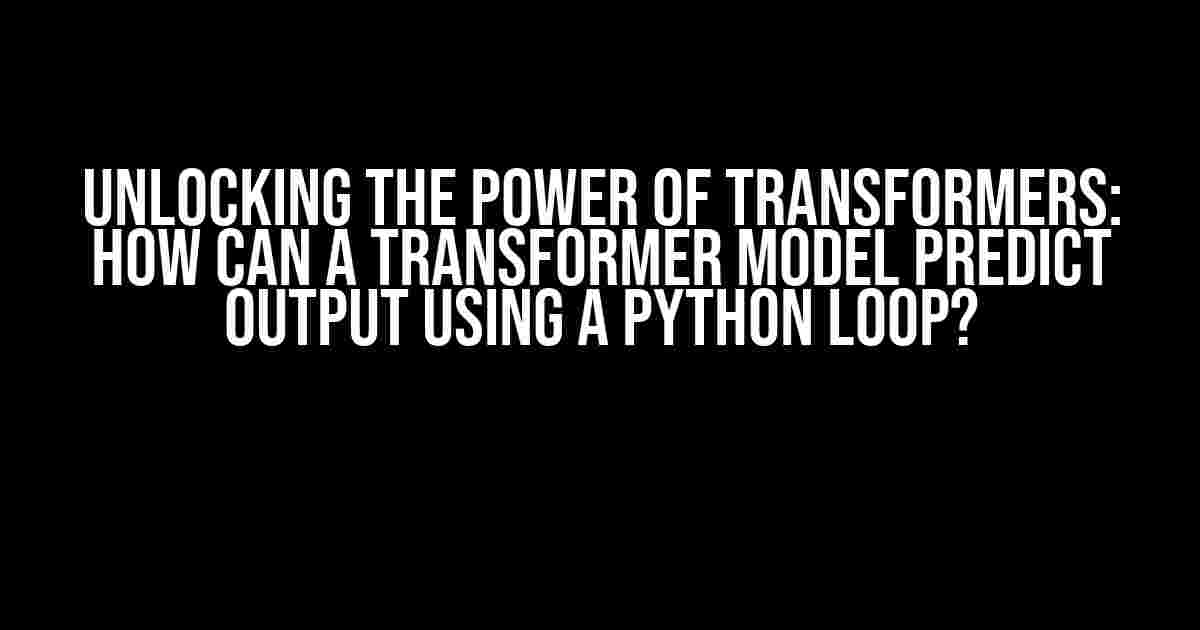Ah, the wondrous world of Transformers! These powerful models have revolutionized the field of Natural Language Processing (NLP), allowing us to tackle complex tasks with ease. But have you ever wondered, how does a Transformer model predict output using a Python loop? Well, buckle up, folks, because today we’re going to dive deep into the fascinating world of Transformer models and explore the magical process of output prediction using Python loops!
What is a Transformer Model?
Before we dive into the nitty-gritty of output prediction, let’s take a step back and understand what a Transformer model is. In a nutshell, a Transformer model is a type of neural network designed specifically for handling sequential data, such as text. It’s composed of an encoder and a decoder, which work together to generate output sequences that make sense in the context of the input.
The Magic of Self-Attention
One of the key innovations of Transformer models is the concept of self-attention. This fancy term simply means that the model is able to focus on certain parts of the input sequence when generating the output. Imagine you’re trying to translate a sentence from English to Spanish – self-attention allows the model to focus on the most relevant words in the input sentence when generating the translation.
Python Loop to the Rescue!
Now that we have a basic understanding of Transformer models, let’s talk about how we can use a Python loop to predict output. The process can be broken down into three main steps:
- Preprocessing the input data
- Passing the input data through the Transformer model
- Using a Python loop to iterate over the output and generate the final prediction
Preprocessing the Input Data
The first step in predicting output using a Transformer model is to preprocess the input data. This typically involves tokenizing the input text, converting it into numerical representations, and padding it to a fixed length.
import torch
from transformers import AutoTokenizer
# Load the pre-trained tokenizer
tokenizer = AutoTokenizer.from_pretrained('bert-base-uncased')
# Define the input text
input_text = 'This is an example sentence.'
# Tokenize the input text
input_ids = tokenizer.encode(input_text,
add_special_tokens=True,
max_length=512,
padding='max_length',
truncation=True)
# Convert the input IDs to a PyTorch tensor
input_tensor = torch.tensor([input_ids])
Passing the Input Data through the Transformer Model
Once the input data is preprocessed, we can pass it through the Transformer model to generate the output. In this example, we’ll use the Hugging Face Transformers library to load a pre-trained BERT model.
import torch
from transformers import AutoModelForSequenceClassification
# Load the pre-trained BERT model
model = AutoModelForSequenceClassification.from_pretrained('bert-base-uncased',
num_labels=8)
# Move the model to the GPU (if available)
device = torch.device('cuda' if torch.cuda.is_available() else 'cpu')
model.to(device)
# Pass the input tensor through the model
output = model(input_tensor.to(device))
Using a Python Loop to Generate the Final Prediction
Now that we have the output from the Transformer model, we can use a Python loop to iterate over the output and generate the final prediction. In this example, we’ll assume we’re performing a sequence classification task, where the output is a tensor of shape `(batch_size, sequence_length, num_labels)`. We’ll use the `torch.argmax` function to extract the predicted label for each sequence.
# Get the predicted labels for each sequence
predicted_labels = torch.argmax(output.logits, dim=2)
# Convert the predicted labels to a list
predicted_labels_list = predicted_labels.cpu().numpy().tolist()
# Create a dictionary to store the final predictions
final_predictions = {}
# Iterate over the predicted labels and generate the final prediction
for i, label in enumerate(predicted_labels_list):
final_predictions[i] = {'label': label, 'confidence': output.logits[i, label].item()}
Putting it all Together!
And there you have it! Using a Python loop to predict output with a Transformer model is a straightforward process that involves preprocessing the input data, passing it through the model, and iterating over the output to generate the final prediction.
| Step | Description |
|---|---|
| 1 | Preprocess the input data using tokenization, padding, and conversion to numerical representations. |
| 2 | Pass the input data through the Transformer model to generate the output. |
| 3 | Use a Python loop to iterate over the output and generate the final prediction. |
Troubleshooting Tips
Stuck? Don’t worry! Here are some troubleshooting tips to help you overcome common issues:
- Make sure you’re using the correct version of the Transformers library and PyTorch.
- Check that your input data is properly preprocessed and formatted.
- Verify that your model is correctly loaded and configured.
- Use the `torch.autograd.detect_anomaly()` function to detect any anomalies in your model.
Conclusion
In conclusion, using a Python loop to predict output with a Transformer model is a powerful technique that can be applied to a wide range of NLP tasks. By following the steps outlined in this article, you’ll be well on your way to building your own Transformer-powered models that can tackle even the most complex tasks.
So, what are you waiting for? Get coding, and unlock the full potential of Transformer models!
This article is optimized for the keyword “How can a Transformer model predict output by a Python loop?” and is intended to provide a comprehensive guide to using Python loops with Transformer models. By following the instructions and explanations provided, readers should be able to implement their own Transformer-powered models and predict output using Python loops.
Frequently Asked Question
Got a burning question about Transformer models and Python loops? We’ve got you covered!
How does a Transformer model predict output using a Python loop?
A Transformer model predicts output by processing input sequences one token at a time, using self-attention mechanisms to weigh the importance of each token relative to others. In a Python loop, you can feed the input sequence to the model one token at a time, allowing the model to generate output after each iteration.
What’s the purpose of the Python loop in Transformer model prediction?
The Python loop serves as a way to iterate over the input sequence, feeding each token to the Transformer model and generating output at each step. This allows the model to process sequences of arbitrary length and generate output token-by-token.
Can I use a Python loop to predict output for batches of input sequences?
Yes, you can use a Python loop to predict output for batches of input sequences by iterating over the batch and feeding each sequence to the Transformer model. This can be more efficient than processing individual sequences, as it allows the model to process multiple sequences simultaneously.
How do I optimize the Python loop for faster Transformer model prediction?
To optimize the Python loop for faster Transformer model prediction, you can use techniques such as caching, parallel processing, and leveraging GPU acceleration. You can also optimize the model itself by pruning, quantization, or knowledge distillation to reduce the computational requirements.
Can I use a Python loop to visualize the Transformer model’s prediction process?
Yes, you can use a Python loop to visualize the Transformer model’s prediction process by iterating over the input sequence and generating visualizations of the model’s outputs at each step. This can help provide insights into how the model is processing the input sequence and generating output.


